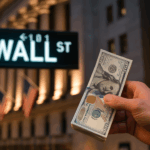Market volatility and economic uncertainty are focal points as JPMorgan Chase’s CEO Jamie Dimon issues warnings of a possible significant stock market correction in the coming years. His cautionary stance comes in response to a myriad of geopolitical and fiscal challenges that could destabilize financial stability. Dimon remarks on the world’s increasingly precarious state, urging preparedness while drawing connections between economic conditions and broader societal factors. This recent discussion is a continuation of Dimon’s previous cautions which showcase recurring concerns tied to a variety of risk factors impacting the global market.
In previous years, Dimon has frequently highlighted the potential threats that could disrupt global economic stability. His statements serve to amplify ongoing concerns regarding factors like geopolitical tensions and fiscal spending, which he argues necessitate a heightened level of vigilance. Compared to earlier remarks, Dimon’s current warning underscores a continued prediction about the economy’s fragility and vulnerability due to these complexities.
What are Dimon’s Concerns?
Dimon points to several pivotal issues contributing to the economic uncertainty. He underscores potential risks from global geopolitical tensions, fiscal spending patterns, and ongoing military escalations. These elements, according to Dimon, create numerous complexities in achieving steady financial conditions. He emphasizes the necessity for investors and policymakers to consider these risks comprehensively.
Is AI Investment Still Promising?
Despite the unpredictable economic landscape, Dimon acknowledges the transformative impact of artificial intelligence (AI) investments. While he foresees that not all AI investments will succeed, he maintains confidence in AI’s potential long-term benefits. This view mirrors historical advancements in technology, where broad adoption ultimately led to substantial gains, despite initial setbacks. Dimon remarks, “AI in total will pay off,” parallel to historical examples in the automobile and television industries.
The conversation around AI investment aligns with Dimon’s long-standing focus on technological innovation as a crucial element for economic resilience. He draws parallels to past economic adjustments, noting the need for strategic investment to foster growth amid uncertainty.
Dimon also revisits themes of caution regarding policy changes and their economic repercussions. From tariffs to immigration policies, he signals the need for comprehensive analysis as the full effects of these changes unfold over time. His observations hint at extended cycles impacting economic adjustments, necessitating patient evaluation.
Overall, Dimon’s messages consistently advocate for a balanced approach that considers both potential opportunities and risks. Current declarations continue to reinforce this stance, combining caution with optimism regarding future economic prospects. Dimon’s diversified insights provide a framework for anticipating the direction of financial markets in light of prevailing uncertainties. His focus remains on assessing systemic risks posed by evolving global dynamics and technological investments.










